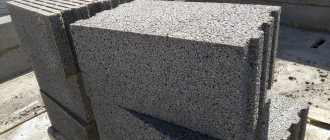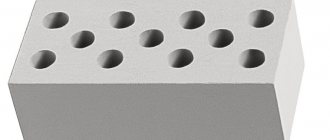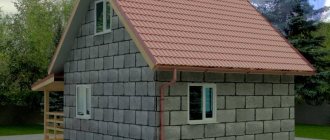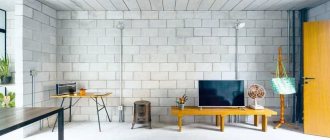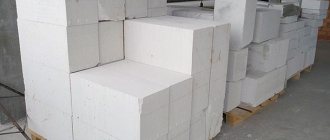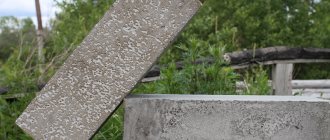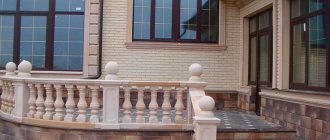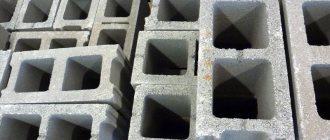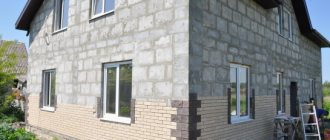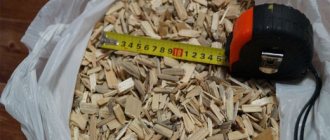Foam concrete blocks are used instead of products made from classic concrete, as they have a number of advantages. But they should be used taking into account the load, since there are many air bubbles in the structure. There are different types of foam blocks, different in size and weight.
When choosing, it is necessary to take into account their main parameters and the intended purpose of the object, its dimensions, which will allow determining the sufficient load-bearing capacity of the building material.
What is foam concrete
This is the name of a porous material that is produced using foaming additives. There are synthetic and organic impurities used to change the properties of the material. Due to this, the weight of foam concrete is reduced. However, the material contains cement.
As a result, fairly durable products are obtained. Moreover, their properties improve with use. Thus, the strength of the foam block after 30-40 years of service increases by 3-4 times. This allows the structure to be used for much longer. When studying the question of what foam concrete is, you should find out what it consists of.
So, the main components are standard: water, sand, cement. When choosing additives, preference should be given to organic materials. They have a protein base, which makes it possible to obtain more durable foam concrete blocks. The cost of such products is much higher than analogues containing synthetic additives.
Cheaper materials have a significant drawback - they belong to hazard class 4. Despite this, the finished foam concrete block cannot cause harm to health. Only the working solution is dangerous. When foam concrete is mixed, the composition changes: additives are added that form foam. At this stage, you should work carefully with the finished mass. As they harden, the toxicity of synthetic additives decreases.
When considering the question of what a foam block is, you need to consider the following: such a product is produced using different technologies, which will determine the quality of the edges, their smoothness, and dimensions. Even large bricks can weigh little.
This parameter is determined by the properties of foam concrete: the finished mass contains air bubbles, resulting in the formation of a porous material. Moreover, the density of the foam block is small. You can increase it using bulk components: clay, ash.
At the same time, the strength of foam concrete increases, since the reliability of the partitions between the pores increases. At the same time, there is a reduction in cement costs, as its consumption is reduced. This composition of foam concrete has disadvantages - the thermal conductivity of the mixture increases, which is due to a decrease in the size of pores filled with air.
This means that if foam blocks are used, the thickness of the object’s wall must be increased. An alternative option is to use thermal insulation.
Production technology
If you are interested in the question, what are foam blocks, you need to study the intricacies of production. So, first the solution is prepared, using standard proportions for mixing classic concrete. Then the resulting mass is placed in a special mixing container. In addition to water, cement and sand, the foam block contains foaming additives. They are introduced into the mixture when it is placed in the mixing container. A foam generator is used for this.
Additives are a foaming substance in an aqueous solution. If organic components are used, the finished material will be of higher quality. This is due to the significant thickness of the walls between the pores. When foam blocks contain synthetic materials, strength decreases. It is not recommended to use such material for the walls of a residential building.
The process of mixing components occurs under pressure. After this, a monolithic slab is formed, which will then be cut into bricks. Another method is also common, in which forms are filled with foam concrete; the density in both cases is the same.
The size of the foam blocks and the degree of smoothness of the surfaces of the edges differ. When a monolithic slab is cut, products of any length and width can be made.
Having figured out what foam blocks are made of, you need to learn more about drying technology. Excess moisture evaporates from the material naturally. Due to this, the uniformity of the fine-cell structure is reduced. The manufacturing technology is quite simple; in addition, much less cement is used. However, its amount cannot be further reduced. In this case, the pores combine with each other, forming channels, which will lead to an increase in the intensity of moisture absorption by the blocks.
The density of foam concrete decreases, and at the same time its strength decreases. As a result, foam blocks, which contain little cement and quite a lot of foaming agents, will serve for a short period, because they quickly collapse.
Materials and tools for work
Before building interior partitions from foam blocks, they should be purchased in sufficient quantities and other materials and tools should be prepared:
- cement mortar;
- glue for foam blocks - the choice depends on the purpose. Most often they prefer: “Osnovit Selform” for winter masonry, “Rusean”, “Volma Blok”. Consumption when laying with a 2 mm seam – 15 kg/m3;
- construction foam - useful for eliminating gaps between the ceiling and the wall;
- foam spray gun;
- self-tapping screws with embedded metal pins;
- medium-width spatula and trowel;
- a special container for mixing glue and cement mortar;
Adhesive for foam blocks IVSIL/IVSIL BLOCK
- a hammer with an attachment for working with rubber - used to level the position of blocks;
- building level;
- corner with saw;
- a grater for leveling the surface of blocks at the surface grinding stage, as an alternative - a plane;
- The wall chaser is used to create holes in concrete, foundations and lay reinforcement in them. You can use a homemade wall chaser or electric mill;
- a wide brush to remove dust from concrete before applying the adhesive mixture.
Having prepared the materials and tools, it’s worth considering whether thermal insulation is needed. Foam concrete has a high thermal insulation ability even without additional coating, but for partitions with unheated rooms it is recommended to install an additional layer of insulation.
Specifications
GOST 21520-89 determines the composition and properties of the mixture. Characteristics depend on the ratio of components. Some error in the quantity of materials is allowed, but it is important that it is small.
Characteristics of foam blocks:
- when mixing the mixture, use Portland cement with calcium silicate in a volume of 70-80%;
- It is recommended to use clay components - no more than 3%;
- quartz sand is used in quantities up to 75%;
- the foaming agent consists of caustic soda, scrubber paste, hide glue, rosin;
- Additionally, the composition may include finely dispersed fly-over resin;
- high strength is ensured by reinforcing fiber or fiberglass;
- density varies from 150 to 900 kg/m³, which depends on the type of concrete;
- thermal conductivity indicators: 0.08-0.38 W/m*K;
- The vapor permeability of foam concrete also changes, the characteristics depend on the brand of the mixture;
- frost resistance varies from F15 to F50;
- Compressive strength range: 0.75-12.5.
Advantages and disadvantages
Having studied the characteristics of foam concrete, the main positive qualities are identified:
- high strength: load-bearing structures of low-rise buildings can be erected;
- low density of the solution, based on this the level of load exerted on the soil is determined;
- low thermal conductivity, which is due to the porous structure of the material, large sizes of foam concrete blocks (this ensures energy saving);
- when a foam concrete block is studied, its characteristics make it possible to reduce the cost of sound insulation of an object, since such products retain noise;
- fire resistance: the thickness of the foam block can be any, this does not affect the ability of the material to withstand high temperatures, which means that if a dangerous situation arises, such products will not lose their shape and properties;
- resistance to moisture: the service life of foam concrete is increased due to the material’s ability to withstand the effects of water, this is due to the presence of a large number of closed pores;
- when it is planned to use foam concrete as the main material, the sizes of the blocks can be different, the products are easy to cut, they are adjusted to the required dimensions;
- environmental friendliness of the material containing organic additives;
- large sizes of the foam block: due to this, installation is accelerated, because instead of many small-sized products, you need to install several large blocks.
If you plan to purchase foam blocks, their pros and cons are taken into account before purchasing. The disadvantages include the unaesthetic appearance of the structure. Surfaces must be coated.
In addition, the long service life of foam concrete is ensured only if the quality of the products is controlled: the geometry of the blocks and the smoothness of their edges are checked. The permissible error is 2 mm.
Table of dimensions, sizes
Main product sizes:
| Height, cm | Width, cm | Length. cm | Number of full-size foam blocks in 1 m³ |
| 20 | 25 | 62,5 | 32 |
| 20 | 29 | 59 | 29 |
| 20 | 30 | 60 | 27 |
| 20 | 40 | 60 | 20 |
| 25 | 25 | 62,5 | 25 |
| 25 | 30 | 62,5 | 21 |
| 25 | 35 | 62,5 | 18 |
| 25 | 37,5 | 62,5 | 17 |
| 25 | 40 | 62,5 | 16 |
| 25 | 50 | 62,5 | 12 |
Among the existing ones, there are standard sizes of foam blocks for walls, for example, products 60x20x30 and 60x30x20 cm. The semi-block is smaller in width. At the same time, the standard size of the foam block is 60x10x30 cm. The dimensions of products from different manufacturers may vary. In addition, at the stage of manufacturing foam blocks, the dimensions are determined individually - when cutting a monolithic slab.
Types and weight
There are:
- structural blocks: used in the construction of load-bearing structures, they can be identified by the grade of concrete: D1000-D1200;
- structural and thermal insulation: used in the construction of load-bearing structures and for the purpose of thermal insulation, the grade of concrete is D600-D900;
- thermal insulation: they are used only to reduce heat loss at the site, their strength level is low, the use of foam concrete grade D100-D300 is justified when constructing internal partitions.
When you plan to purchase foam blocks, their types differ in size, density, and weight. The combination of parameters determines where the material will be used.
Foam block weight depending on density:
- structural: 39-47 kg, half-block weight varies from 19 to 23 kg;
- structural and thermal insulation: 23-35 kg, the weight of the half-block reaches 17 kg;
- thermal insulation: 11-19 kg, half-block weighs no more than 10 kg.
Moreover, the weight of one foam block is indicated taking into account the level of air humidity. This is due to the ability of the material to absorb small amounts of moisture. The most accurate value of this parameter can be determined if the humidity level does not exceed 75%.
Low compressive strength
The dimensions of foam concrete blocks do not affect load resistance. If the production technology is followed, the material is reliable. However, sometimes at the stage of preparing the solution, cement of low quality or the wrong brand is used. For this reason, it is recommended to check the material quality certificate. The use of products with inappropriate parameters leads to the collapse of the structure.
You can check the quality of the material yourself. To do this, drive a nail at least 10 cm long. If it cannot be pulled out without using a tool, it means that the block is sufficiently strong.
When deciding what size foam block to choose, how much material is needed and where it can be purchased, different options are considered, including the use of products that are stored after production for less than 28 days. Their cost is often lower, but this is due to low brand strength.
Such blocks are more susceptible to shrinkage and cracking. Products that have not gained strength after hardening should not be used in construction.
Construction Features
A necessary condition for the construction of objects is the reinforcement of load-bearing structures. Strengthen every 4-5 row, as well as areas where the openings are located. According to this principle, any objects are built: one-story and low-rise buildings. Thanks to reinforcement, the reliability of the structure increases, and at the same time its service life.
Acceptable density is D500 and higher. When load-bearing walls are erected, not only the thickness of the foam blocks is determined, but also other parameters, in particular frost resistance. An indicator of at least F50 is considered sufficient. This will allow the object to withstand exposure to low temperatures longer. If the frost resistance index is low, the walls will soon begin to crack.
Special materials are used for finishing. If you choose universal plaster mixtures, paint, the cladding layer will not last long. You can further increase the service life of the structure. To do this, during the construction period the object is protected from moisture with covering materials. If you plan to use a foam concrete block, the dimensions must be significant. The recommended masonry thickness in central regions is 64 cm.
Fastening Features
The material is characterized by low mechanical strength, which does not allow the blocks to be securely fastened with self-tapping screws and nails, although such fasteners are inserted into the foam concrete structure in the same way as into wood. It is better to use a variety of products with widening on one side.
The end part expands after inserting the fasteners to the required depth. Standard anchors and dowels will not provide sufficient reliability. This fastener is designed specifically for porous materials. There are products made of metal, nylon and plastic.
Marking
The manufacturer is required to apply markings to each batch of foam blocks. The “cipher” can be on the package or on 1-2 blocks. Typical example:
Block II/600×300×200/D600/B3.5
This means that we have foam concrete of category II , suitable for masonry with mortar. Length - 600 mm, width - 300 mm, height - 200 mm. Density grade - D600 , compressive strength class - B3.5 .
Areas of application
Foam blocks are used in the construction of low and medium-rise buildings for various purposes. This material is inferior to concrete in strength; even reinforcement does not help to completely solve this problem. Foam blocks are used in the construction of industrial buildings and private houses. They are used when load-bearing walls and internal partitions are built, as well as for the purpose of thermal insulation of an object.
In each case, different types of products are used: structural (the most durable), structural and thermal insulation, thermal insulation. The first option is characterized by insufficiently low thermal conductivity, which is why the building is additionally insulated. Thermal insulation products, on the contrary, are much less durable compared to structural analogues, but retain heat better.
Conclusion
When planning a renovation in your apartment, try to choose the most suitable material. The modern market is overflowing with worthy products that are affordable and will provide high-quality results.
Don’t forget to get permission for redevelopment, think over an action plan, and your renovation will be a success. Taking into account the features of your apartment, you can competently arrange your comfort.
In the video presented in this article you will find additional information on this topic.
Prices for foam blocks
The cost of foam blocks in Moscow and the regions differs. Pricing is influenced by the quality of the material, its properties, and product dimensions. Structural blocks are more expensive. Their price reaches 4500 rubles. for 1 m³. Structural and thermal insulation material costs between 3200-3800 rubles. for 1 m³. The price of thermal insulation products is much lower. The upper limit of the cost range is RUB 3,000. for 1 m³.
The higher the quality of the blocks, the greater the difference in price compared to simpler material. In addition, the price should be too low.
Such material can quickly sell out at an affordable price, because it has not gained strength or low-quality cement was used in production. There is a risk of purchasing such products at a high cost, so you need to ask about the availability of accompanying documentation.
Which is more profitable: aerated concrete block or foam block
The foam block does not allow air to pass through, because it consists of closed cells. To insulate such a structure, it is permissible to use different types of slabs, including polystyrene foam, which is characterized by the worst properties compared to analogues. Aerated blocks allow air to pass through, so in this case it is better to use insulation, which is similar in properties - it is a breathable material.
If we compare 2 types of blocks in terms of strength, then aerated concrete products are 3-4 times superior to their foam block counterpart. In addition, plaster compositions lie more evenly on the surface of such material, which simplifies the cladding work.
However, aerated blocks should not be used for the construction of objects in areas where there is a high risk of constant contact with moisture: high groundwater levels, high air humidity, frequent rains. This material quickly absorbs liquids.
It is noted that both types of blocks differ in pore size. So, a gas block has an advantage - the cells in the structure of the material are the same. This ensures uniform distribution of air throughout the masonry, and thermal conductivity remains unchanged in different areas of the structure.
Another difference is the type of additives. Aerated concrete is an environmentally friendly material. For comparison, foam concrete is sometimes made from toxic components (foaming additives of synthetic origin).
Recommendations
Structures of various types and purposes are made from foam blocks:
- the material is resistant to high humidity. If you are wondering whether it is possible to build a bathhouse from foam blocks - yes, the bathhouse is quick and easy, but the material will still need additional coating;
- all materials have their own characteristics; foam blocks, pros and cons, are discussed in detail in a separate article;
- You can build houses from foam concrete, but only low-rise ones. The construction of foam block houses requires reinforcement of the structure with a metal frame, this leads to the reliability of the structure and prevents the appearance of cracks;
- Many people confuse aerated concrete and foam concrete, but these are different materials. The main difference between foam block and aerated concrete is its closed structure; therefore, foam concrete does not absorb moisture.
- Foam block partitions can be made by beginners in construction; no special skills are required during the construction process. Observing the nuances of construction from foam blocks, the structure will last 40 years or more.
